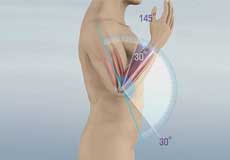
What is Elbow Contracture?
Elbow contracture refers to a stiff elbow with a limited range of motion. It is a common complication following elbow surgery or elbow trauma, such as fractures, dislocations, and burns.
The normal range of motion for an elbow is approximately 0-145 degrees. A stiff or contracted elbow may be diagnosed when the ability to extend or flex the arm is lessened by 30 degrees or more. Flexion contractures greater than 45 degrees will significantly affect your ability to perform activities of daily living such as bathing and eating.
Symptoms of Elbow Contracture
The symptoms of elbow contracture include the following:
- Stiffness of the elbow
- Inability to fully extend or flex the arm
Causes of Elbow Contracture
The causes and risk factors associated with elbow contracture include:
- Elbow trauma
- Elbow surgery
- Osteoarthritis
- Rheumatoid arthritis
- Loose bodies
- Osteophytes or bone spurs
- Malunions of fractures
- Joint infection
- Burns
Diagnosis of Elbow Contracture
Elbow conditions should be evaluated by an orthopedic surgeon for proper diagnosis and treatment. Your surgeon will review your medical history, perform a physical examination and order diagnostic studies such as an X-ray, CT scan, or MRI.
Treatment options for Elbow Contracture
Conservative Treatment for Elbow Contracture
Conservative measures can successfully treat most elbow contractures of less than 6 months duration. These options will be based on your condition and may include the following:
- Physical therapy
- Splinting
- Casting
- Manipulation
Surgical Treatment for Elbow Contracture
If conservative treatment options fail to improve the elbow contracture despite your adherence to physical therapy, surgery may be recommended.
Capsular release is a surgical procedure to release the contracture associated with elbow stiffness. This surgery is typically performed through an open incision to release the structures that are stiffening the elbow. Elbow contracture release is performed in a hospital operating room under general or regional anesthesia.
Your surgeon will discuss the options with you and decide which surgical technique will be best for your condition.
Postoperative Care after Elbow Capsular Release
After surgery, your surgeon will give you instructions to follow depending on the type of procedure performed. Common postoperative care following elbow contracture release includes the following:
- Initially, you will have a bulky bandage from your shoulder to your hand to minimize swelling and bleeding.
- Elevate the elbow on a pillow and applying ice packs over the dressing to help reduce swelling.
- Continuous passive range of motion may begin within a day after surgery.
- Keep the incisions clean and dry. You may shower once the dressings are removed unless otherwise directed by your surgeon.
- You will be given specific instructions regarding activity and rehabilitation. It is imperative that you comply with physical therapy directions for the best outcome from your surgery.
- Eating a healthy diet and quitting smoking will promote healing.
Risks and Complications after Elbow Capsular Release
Potential complications following elbow contracture release include injury or irritation to the nerves around the elbow, the development of elbow instability due to excessive release, bone fracture following manipulation and recurrence of the contracture. Infection is also a risk.
Related Topics
- Triceps Injuries
- Osteochondritis Dissecans of the Capitellum
- Elbow Trauma
- Elbow Arthritis
- Bicep Tendon Tear at the Elbow
- Elbow Dislocation
- Triceps Tendonitis
- Elbow (Olecranon) Bursitis
- Elbow Sprain
- Tennis Elbow
- Golfer's Elbow
- Little League Elbow
- Nursemaid's Elbow
- Elbow Pain
- Elbow Contracture
- Distal Humerus Fractures of the Elbow
- Radial Head Fractures of the Elbow
- Elbow Fractures
- Ulnar Nerve Neuropathy
- Loose Bodies in the Elbow
- Radial Tunnel Syndrome
- Lateral Ulnar Collateral Ligament Injuries (Elbow)
- Post-traumatic Stiffness (Elbow)
- Cubital Tunnel Syndrome (Ulnar Nerve Entrapment)





